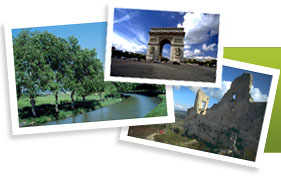Select Travel Guide...
Arras
Arromanches
Auvergne
Bayeux
Boulogne
Brittany
Calais
Champagne - Reims
Charente
Clecy
Deauville & Trouville
Dieppe
Dordogne
Honfleur
Languedoc
Le Touquet
Loire
Normandy
Omaha Beach
Paris & Versailles
Pas-de-Calais
Picardy & Pas de Calais
Provence Côte d'Azur
Strasbourg
Vendée
Calais Guide
The Six Burghers Monument
The statue of the Six Burghers was sculpted by Rodin in 1895 and is Calais’ most famous monument. The statue represents the six noblemen who surrendered themselves to Edward III of England, following the siege of the city, on 4th August 1347, in order to save the townsfolk. Edward’s wife, Queen Philippa de Hainault, successfully asked her husband to spare their lives. The city then remained in English hands until 1558.
Calais Town Hall
Due to the success of the lace-making industry, the population in the village of Saint-Pierre increased greatly and in 1885 it merged with Calais. Work began on the new Town Hall in 1911 although it was not completed until 1925 because of World War I. The Town Hall was built in a Flemish Renaissance style and the spire of the belfry reaches 75m high from where electric bells ring out the hours.
The Citadel
Built on the site of a medieval castle that was built in 1229 by order of Philippe Le Hurperel, Lord of Boulogne, and partially financed by the inhabitants of Calais to provide protection from their enemies. The Lords of Boulogne and Artois first lived there and later it became the residence of the English Kings, including Edward III, until 1558. The French King then decided to turn it into a great fortress by building a citadel, designed by Vauban. Nowadays, the Mediaeval ramparts and the "Boulogne door" can still be seen.
Nieulay fort
Designed by Vauban, the Nieulay Fort was built in 1677. It was used as a tollgate for visitors to the city but also the locks of the fort were designed to flood the land around the walled city of Calais in the event of attack and thus prevent the enemy from advancing. Nowadays, the ruins of the fort form part of a pleasant park.
The Risban Fort
The Risban Fort was built during the Hundred Year Wars, in 1328 and in 1622, under Louis XIII, became the starting point for the construction of a sea wall running along the coast to Sangatte. In 1850 the Fort was the main defence for the harbour, and during the World War II many residents of Calais used it as a shelter during the bombardments of the town.


